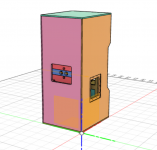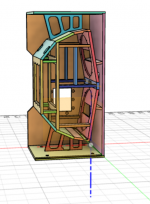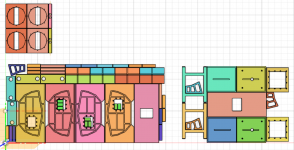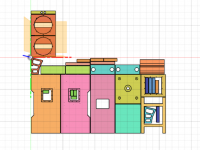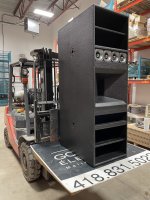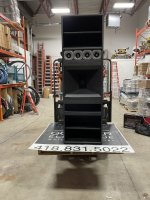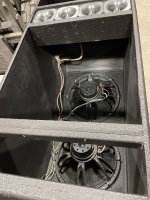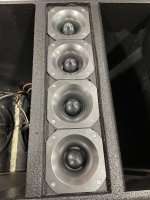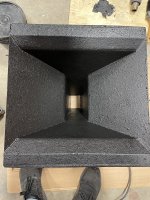Indeed that’s what I use.A single 18 BR cabinet can not keep up with the PM60/90. A tapped horn like the TH118 has much more output (but is twice the size/weight). 4 tapped horns with the 18sw115 would be a perfect fit and will put a smile on your face :-D
I’m using one TH118 with 18sw115 per side (limited by my transport) with PM90 and I feel I could use some more sub (mostly on outdoor events). I think the PM90/TH118 combo is about the most powerful, compact sub-top set that you can build at the moment and that can be handled by one person.
New DIY Mid High (90deg) - AKA PM90
- Thread starter Peter Morris
- Start date
You are using an out of date browser. It may not display this or other websites correctly.
You should upgrade or use an alternative browser.
You should upgrade or use an alternative browser.
They breath better. There is no perfect sub, but tapped horns and some horn subs do ok. People like KV2 make great bandpass boxes when most around are pretty horrible. Good design is good design.This was our first pick at the moment Rob - and what we'd prototyped - was an easy build. Would love to hear feedback of anyone that has used these (even better so if with the PM90).
Perhaps a couple of rookie questions here - but really interested in your perspective here. Why do you feel tapped horns are a good solution for the PM90's? And what do you mean when you say that reflex boxes are a bit hard going these days?
For those interested - we've been doing a bit of digging around on what to stack with the PM-90's, and are down to two options - both tapped horns.
Thinking to go with 2 x Skram (https://data-bass.ipbhost.com/topic/742-riccis-skram-subwoofer-files/) per side, or 2 x TH-118 (https://www.diyaudio.com/forums/subwoofers/190635-th-18-flat-35hz-xoc1s-design-282.html) per side.
Our preference at this stage is the Skram, but we don't have 21" drivers. Hoping someone will run some sims on the 18SW115's in that cabinet before we proceed.
After the Skram / TH-118's, we're thinking of a a couple of MTK 215 Mk3's ( http://hornplans.free.fr/martin_mk3.html) or similar.
Thinking to go with 2 x Skram (https://data-bass.ipbhost.com/topic/742-riccis-skram-subwoofer-files/) per side, or 2 x TH-118 (https://www.diyaudio.com/forums/subwoofers/190635-th-18-flat-35hz-xoc1s-design-282.html) per side.
Our preference at this stage is the Skram, but we don't have 21" drivers. Hoping someone will run some sims on the 18SW115's in that cabinet before we proceed.
After the Skram / TH-118's, we're thinking of a a couple of MTK 215 Mk3's ( http://hornplans.free.fr/martin_mk3.html) or similar.
That's fairly pessimistic, though it might be true since the KS still has the signature SB28 port chuff, annoyingly. I'm honestly not sure if I'd use the KS28 as a starting point besides the general form factor and driver complement.
Whats pessimistic about it? KS28 is from what I have read, pretty much the benchmark. Chuffing would also be low compared to other dual 18 competitors. What dual 18 would be your starting point?
Subwoofer design isn't that hard, and doesn't require that many iterations if you design it well. I suppose recreating the KS28 and all of it's compromises, then all of the solutions and marketing to overcome those compromises could require "extensive testing" and "multiple test cabinets"... My dislike of the KS28 aside, the principles of subwoofer design are pretty much just Hoffman's Iron Law and deciding on the drivers you can afford to buy.Whats pessimistic about it? KS28 is from what I have read, pretty much the benchmark. Chuffing would also be low compared to other dual 18 competitors. What dual 18 would be your starting point?
I'm typically known as a d&b fanboy, but in this case I'm actually not - their subs aren't really the benchmark for anything except maybe B22, which is pretty good. My big issues with the KS28 are:
- Needlessly poor truck pack dimensions (SL-Sub is similarly irritating to truck pack). What's up with everyone forgetting about standard truck pack sizes when designing subwoofers these days? I don't want to have to purchase an extra cart which further increases the footprint just for the privilege of having it fit side by side in a truck! Anything wider than 48" is unlikely to fit in most trucks, and not every show demands a semi. For SL-sub, I understand the limitations of the front area with dual 21" drivers, but for a dual 18" the heck is up with that 52" width?
- L-Vents are a marketing scheme and I don't entirely buy it. I've read the JBL study which suggests that the L-vent port shape is the way to go, but there's enough subwoofers that aren't chuffy (which the KS28 definitely from what I've heard in person and from others) and use more or less regular ports that it's hard to buy.
- KS28 is a single chamber approach. As a result, the area in the cabinet is starting to become greater than 350L - that's typically where you start to be able to really tell that the cabinet is too large. I think this contributes to the sound that people who don't particularly like the KS28 describe. To be fair, d&b subs besides the B22 have the same sort of attribute, but that's more to do with the forced cardiod design IMO.
- Their cabinet tuning is particularly low, which I don't really like.
Actually for a front loaded dual 18 design, the second tier manufacturers really have this down - CODA, Martin, etc. all make far more truck-packable designs that perform nearly as well. The only area they don't typically perform as well is below maybe 30-35 Hz, but with things like the SCP-F available now, that is becoming less of a weakness.
Getting the portlength right in practise is not that easy because to my knowledge, not one simulation program can design for example a shelved port right. You will end up with a correction that needs to be done in practise, hence the multiple versions.
-I would say truck pack dimesions are pretty allright for the KS28. Four a side give 226cm or three on carts give 210cm (without covers).
Most of the times, KS28 will be used in large venues. rolling carts with three stacked makes placement very easy.
-With drivers like the one used in the KS28 (something like the B&C 18SWX100) you will need large vents (without L vents around 0,5 times Sd) to counter noise and portlosses as much as possible. This gives the problem that you need long ports which need to fit in a certain box size (with al problems that come extra with long ports). L-vents/curved/laminar do counter this problem with better airflow and smaller portarea, which then again gives a shorter port.
-I would say the chamber volume is even smaller then 350L for both drivers. And I would say thats even small for the used drivers.
-The low tuning can give extra dimensions to the sound experience with the proper source material. Some interesting AES papers are written about that.
-I do know the B22/B2 and can appreciate the sound, but they still are a 'one-note wonder'. Did not hear the newer SL, but traingle ports are factual more compromised due to the losses involved.
-SCP series of Coda are cool, but heard they are not as loud as most dual 18's.
-I would say truck pack dimesions are pretty allright for the KS28. Four a side give 226cm or three on carts give 210cm (without covers).
Most of the times, KS28 will be used in large venues. rolling carts with three stacked makes placement very easy.
-With drivers like the one used in the KS28 (something like the B&C 18SWX100) you will need large vents (without L vents around 0,5 times Sd) to counter noise and portlosses as much as possible. This gives the problem that you need long ports which need to fit in a certain box size (with al problems that come extra with long ports). L-vents/curved/laminar do counter this problem with better airflow and smaller portarea, which then again gives a shorter port.
-I would say the chamber volume is even smaller then 350L for both drivers. And I would say thats even small for the used drivers.
-The low tuning can give extra dimensions to the sound experience with the proper source material. Some interesting AES papers are written about that.
-I do know the B22/B2 and can appreciate the sound, but they still are a 'one-note wonder'. Did not hear the newer SL, but traingle ports are factual more compromised due to the losses involved.
-SCP series of Coda are cool, but heard they are not as loud as most dual 18's.
I suppose I may have just gotten used to the error and correction factors for the port styles that I often use.Getting the portlength right in practise is not that easy because to my knowledge, not one simulation program can design for example a shelved port right. You will end up with a correction that needs to be done in practise, hence the multiple versions.
-I would say truck pack dimesions are pretty allright for the KS28. Four a side give 226cm or three on carts give 210cm (without covers).
Most of the times, KS28 will be used in large venues. rolling carts with three stacked makes placement very easy.
-With drivers like the one used in the KS28 (something like the B&C 18SWX100) you will need large vents (without L vents around 0,5 times Sd) to counter noise and portlosses as much as possible. This gives the problem that you need long ports which need to fit in a certain box size (with al problems that come extra with long ports). L-vents/curved/laminar do counter this problem with better airflow and smaller portarea, which then again gives a shorter port.
-I would say the chamber volume is even smaller then 350L for both drivers. And I would say thats even small for the used drivers.
-The low tuning can give extra dimensions to the sound experience with the proper source material. Some interesting AES papers are written about that.
-I do know the B22/B2 and can appreciate the sound, but they still are a 'one-note wonder'. Did not hear the newer SL, but traingle ports are factual more compromised due to the losses involved.
-SCP series of Coda are cool, but heard they are not as loud as most dual 18's.
I don't know where you're calculating those numbers but my point is that you certainly can't build a row with KS28 and SL-Sub horizontally across the truck. It's just less options and a 50" + wide cabinet is starting to get uncomfortably wide. I agree that the stacked carts are the way to go at the size of event that they are designed for, but with the added cart lip width it just means they'll fit horizontally even less often in a truck.
I've done a lot of experimentation with how much port you actually need relative to Sd, and I was surprised to find it was often less than 0.5 Sd. It's certainly nice to have that if you can, and with the face area of 22.5" x 48" that would be friendlier to truck pack, I
There's a lot of misconceptions about how the physics behind that shape of port work. There are two things in particular that I find relevant.
First, the shape that L'acoustics is using is based off of the JBL paper. That shape showed the best results experimentally for port distortion and performance before becoming a noisy hole - but not really by all that much where it matters. Sure, at lower excursions, it shows better distortion performance, but near the limits just a straight walled port with flanges on both sides is already extremely close to the performance of the sculpted port. People seem to think the take away is that you need some crazy flared port geometry to deal with vortex shedding and such. However, I think the real takeaway is that symmetrical port flanging has extremely large benefits, as well as that clearly the primary cause of problems in ports at their extremes is the vortex shedding. One of the reasons that ports adjacent to a cabinet wall isn't just that it functions as an extension of the wall port, but more importantly that there is no vortex shedding happening to cause losses.
The second point to make is that at their core ported cabinets are still Helmholtz resonators. That means the critical parameters are the volume of air in the cabinet (C), the mass in the port (L), and the surface area between the two. "Necked" ports, shall we call them, mess are nice because they present a larger apparent surface area for the same mass in the port. The problem is that as the "slug" moves in and out, the impedance matched cross sectional area moves along the flare. It's also possible to have a sudden pressure spike blow out the slug in most necked area of the port, though I have not simulated this explicitly. (Getting more familiar with CFD is somewhere on the stack of TODOs.) I think this, combined with the low tuning, is why SB28 and KS28 seem chuffy despite their fancy "L-Vents" claiming to have laminar flow - I think they actually cause more problems during transients where they help during steady state operation.
I think KS28's internal cabinet volume is yea around 350L from what I have been able find and the measurements available. The issue isn't that the volume is too much per driver. I agree that it's almost on the small side per 18" driver - heck I've even seen some questionable cabinets that use nearly 300L per 18" driver (which is is too much, I think). The issue is that it's a single volume which can resonate as one volume because of the appropriate volume behind the vent that connects the two halves of the cabinet. It's not the primary issue I have with the cabinet but I just don't like to design a volume much larger than 300L.
I totally agree that getting down low to 30 Hz can really make a difference. However, you don't have to tune a port that low to get that output, and sometimes I think cabinets get tuned lower than ideal in pursuit of that extension. That's usually what I take issue with - I just don't think it's a good design compromise unless you're explicitly trying to make an infra-sub.
Personally I've worked a fair bit with B2 and B22. While B2 is definitely a bit of a one-note wonder, I actually find B22 plays quite nicely throughout it's bandpass. The newer motor technology combined with the improvement D80 brought from D12 really helps the driver overcome some of the difficult acoustic impedances presented by the design. I like it way more than I expected to after B2. It's footprint is also smaller than 48" across.
SL-Sub is just so much displacement in a single cabinet. It's truly a behemoth.
I mean, as far as I can tell SCP is an iPAL implementation. It should be louder that most any other 18" as a result of the increased linear excursion that comes with the platform. I think my all time favorite front loaded double 18" is the Clair CP218, but not everyone can afford the cost that comes with the descendant of the bow-tie.
Hi Aaron,
Yes that is the most recent drawing of the double 12 DIY
Peter,
Thanks for this awesome project! I am looking into buying two unloaded PM60 cabs made by another forum member. What is the feasibility of 'converting' an existing 60 degree cab to accept the 90 degree horn? It seems like its just a matter of routering out the mouth of the 90 degree horn shape? is the box any different in other ways?
Thanks,
Hunter
The 60 horn shape is bigger.l than the 90 so theoretically u would have to add a panel on top of existing hole with the small 90 opening..
As Jason said, the 90 horn is smaller so a filler panel will do the trick. The boxes are the same other than the horn used.Peter,
Thanks for this awesome project! I am looking into buying two unloaded PM60 cabs made by another forum member. What is the feasibility of 'converting' an existing 60 degree cab to accept the 90 degree horn? It seems like its just a matter of routering out the mouth of the 90 degree horn shape? is the box any different in other ways?
Thanks,
Hunter
Finally some progress: Parts for my PM90 build are getting CNCed tomorrow in a local woodshop. I used Fusion360 to creat a digital model and plans for a flatpack based on the drawings by Max Warasila. @Peter Morris, I would share the F3d and DXF files here, if you don't mind?
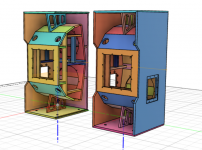

Attachments
Last edited:
In all honesty, I'm going to end up either using yours or making my own this winter. I intend to build four of them. I might rev the design to accommodate the DCX while I'm at it.Finally some progress: Parts for my PM90 build are getting CNCed tomorrow in a local woodshop. I used Fusion360 to creat a digital model and plans for a flatpack based on the drawings by Max Warasila. @Peter Morris, I would share them here, if you don't mind?
from what i read before i thought the dcx would fit the original 90 degrees version (even if tightly)?
That should be correct, but the 60 degree horn is questionablefrom what i read before i thought the dcx would fit the original 90 degrees version (even if tightly)?
I'm just finishing up a pair of mid highs using the HF-950 horn and BnC dcx-464. Going to be starting the tuning process next week. Just curious if anyone has any filter/crossover settings for the DCX on the hf950 horn. I've scoured the forums but have yet to see any posted. Ill be using LIR crossovers on a Linea ASC-48 but would be happy with any standard filter/crossover settings to get me started. Any help is greatly appreciated. Cheers.
Here is my own version of this speaker. Substantially bigger lol. But also more powerful. It’s composed of a pair of b&c 15nw76 for bass. Paired with a bms4599he and 4 ciare ct440. Loudest box I have ever heard by far.
Attachments
Hey Jason. Thank you very much. The horn is a diy horn that me and my brother made out of 3/4 inch birch plywood. The coverage pattern is 90 degrees horizontally and 45 degrees vertically. As for the size imnice horn. whats the specs..
Not exactly sure as I did not do the cutting but as a rough estimate it’s around 21 inches in height by 19 inches in width and probably a good 15 inches deep. If you are interested I wouldn’t mind sending you a video of what this thing is capable of doing.
Attachments
Yes, and hence my question is: Are there any concerns with using 2x 16 Ohms in parallel = 8 Ohms for the mids, in contrast to 2x8Ohm=4Ohms?At the moment there is no version of the PM60/90 with a passive XO between the LF and MF/HF section. So you have to (at least) bi-amp the cab.
2x12NDL76-16 will give you 8 Ohm nominal when parallel.
1x DCX464-8/16 with a passive XO between the MF and HF will give you either 8 Ohm or 16 Ohm nominal.
So this means you need 2 amp and DSP channels per box. Regarding the passive XO for the DCX, I would look at the B&C FB464 or the blue aran offering. Of course you could also design one on you own if you have the ability.
I can get my hands on the 16Ohms version, but can't happen to find an offer for the 8 Ohms version. Just want to doublecheck before spending 700+ Euros on the wrong mids.

